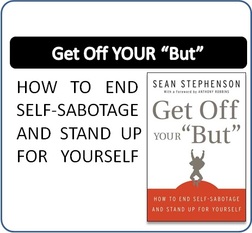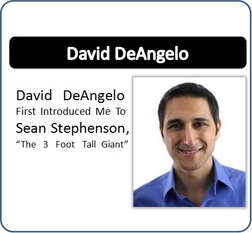Get Off YOUR "But"
This little book has some incredible endorsements from big names ranging from the business literature like Eben Pagan, and Sir Richard Branson, to the self-help gurus like Susan Jeffers, David DeAngelo (who first introduced me to Sean) and Christian Carter. On the back jacket there is a quote from former President Bill Clinton ("Sean is an amazing person with an important message"). And if that’s not enough Tony Robbins wrote the Foreword.
Sean's style is one of encouraging and prodding, but he's not one of those annoying “rah-rah” guy. He's a “optimistic realist”. As Sean says “sometimes life does suck.” According to brain current research (which I probably were you wait too much of), reality is largely what we make it. The brain filters and repackages information before the conscious mind sees it, largely based on preconceptions and what it "ought to" see. The brain is, essentially, a predictive computer and it will predict based on what it perceives rather than what it senses. That is, it makes its own reality. This fact has only recently been verified in the neuroscience field (physical brain studies) but has long been a fundamental premise on the motivational lecture circuit.
This is a little book, written by a little man, with the theory being in message.
Reading Get Off YOUR "But", I could not help but feel a strong connection with Sean as do the family and friends who I have given copies of his book to. Sean comes across as a person who just wants to help others. He makes his message simple and clear, but at the same time he helps the reader dig into complex challenges.
This book consists of seven chapters, I hope I don’t make Sean mad but giving you a look inside the book but here is just a hint of what you will find.
As I mentioned the Foreword was written by Tony Robbins. If you don’t all ready know what an amazing he person is. I personally have a high opinion of Tony Robbins and his work. Tony Robbins is a pioneer in his field and as they say “you can always tell the Pioneers’ because they’re the ones with all the arrows in their back”. In Robbins is no exception, however many of his most vocal critics have been forced to eat crow due to discoveries in brain science over the past few years. Tony Robbins endorsement means a lot. He didn't just throw out a few platitudes and empty praises. He made a point of explaining why Sean's book is a "must read." Tony "brings to life" what he's saying, through specific examples.
Chapter One. Born to Kick But: The Short Story of a Big Life. This is an autobiographical sketch. Here, we learn about Sean's childhood, the challenges he faced, and the object lessons he learned. He introduces us to his core philosophy: cause and effect. It's not a new concept and thus it's not something he made up to attract an audience. I've understood this concept for a very long time, but Sean helped me see it with greater clarity.
Chapter Two. Lesson 1: Start Connecting. There's a huge difference between merely communicating and actually connecting with others. I'm not a fan of President Clinton, but the man is an expert on connecting with people. In this chapter, Sean lists "Ten things I learned about connection from President Bill Clinton." Sean knows Clinton personally, so this isn't an armchair observation kind of thing. This chapter has lots of great information for anyone frustrated with relationships (business or personal).
Chapter Three. Lesson 2: Watch What You Say to Yourself. This gets into the traditional inner dialogue stuff, but takes it up a notch or two. One of the things Sean communicates here is your word choices can have a transformational effect (or not, if they are poor choices).
Chapter Four. Lesson 3: Master Your Physical Confidence. You can usually spot a person who has self-esteem issues, can't you? And why is it some people seem to dominate a room, even if they aren't the best-looking, best-dressed, or loudest person in the room? Sean explains why and what you can do about that.
Chapter Five. Lesson 4: Focus Your Focus. As I type this, I have a painful thumb infection. Guess when it hurts the most? When I'm thinking about it! In this chapter, Sean delves into such things as changing your focus from what you don't have to what you can be thankful for. He talks about directing your mind toward what you want to achieve rather than letting your mental powers drown in a pity puddle.
Chapter Six. Lesson 5: Choose Your Friends Wisely. Sean uses the metaphor of a pit crew to illustrate the differences between A Friends, B Friends, and C Friends. He explains that you can choose your pit crew. Avoid the takers, drainers and destroyers. Re-channel that energy into cultivating real friends. Since there's confusion over what a real friend is, Sean makes this clear.
Chapter Seven. Lesson 6: Take Full Responsibility. Either you own your situations, or they own you. When they own you, it's not good. Sean has a simple formula for understanding how to be in control: C > E. That is, cause is greater than effect. He explains how this works and how it can liberate you. As mentioned earlier, Sean is a psychotherapist. If a client will not agree to work with this formula, Sean ends the session and refunds the client's money. That's how important this is.
Epilogue. One Last Thing.... As it's only one page, it's an epilogue rather than a chapter. It's Sean's final piece of wisdom for applying the lessons in the book.
Resources. Sean lists books and movies "that shaped my life." All of these titles are familiar to me. He also lists excellent online resources for various issues.
There... I hope I didn't give too much away. Get Off YOUR "But" is not a book that you would want to miss. Get your copy today. If you are thinking, "Yeah, but..." then you desperately need it. Don't delay.
Sean's style is one of encouraging and prodding, but he's not one of those annoying “rah-rah” guy. He's a “optimistic realist”. As Sean says “sometimes life does suck.” According to brain current research (which I probably were you wait too much of), reality is largely what we make it. The brain filters and repackages information before the conscious mind sees it, largely based on preconceptions and what it "ought to" see. The brain is, essentially, a predictive computer and it will predict based on what it perceives rather than what it senses. That is, it makes its own reality. This fact has only recently been verified in the neuroscience field (physical brain studies) but has long been a fundamental premise on the motivational lecture circuit.
This is a little book, written by a little man, with the theory being in message.
Reading Get Off YOUR "But", I could not help but feel a strong connection with Sean as do the family and friends who I have given copies of his book to. Sean comes across as a person who just wants to help others. He makes his message simple and clear, but at the same time he helps the reader dig into complex challenges.
This book consists of seven chapters, I hope I don’t make Sean mad but giving you a look inside the book but here is just a hint of what you will find.
As I mentioned the Foreword was written by Tony Robbins. If you don’t all ready know what an amazing he person is. I personally have a high opinion of Tony Robbins and his work. Tony Robbins is a pioneer in his field and as they say “you can always tell the Pioneers’ because they’re the ones with all the arrows in their back”. In Robbins is no exception, however many of his most vocal critics have been forced to eat crow due to discoveries in brain science over the past few years. Tony Robbins endorsement means a lot. He didn't just throw out a few platitudes and empty praises. He made a point of explaining why Sean's book is a "must read." Tony "brings to life" what he's saying, through specific examples.
Chapter One. Born to Kick But: The Short Story of a Big Life. This is an autobiographical sketch. Here, we learn about Sean's childhood, the challenges he faced, and the object lessons he learned. He introduces us to his core philosophy: cause and effect. It's not a new concept and thus it's not something he made up to attract an audience. I've understood this concept for a very long time, but Sean helped me see it with greater clarity.
Chapter Two. Lesson 1: Start Connecting. There's a huge difference between merely communicating and actually connecting with others. I'm not a fan of President Clinton, but the man is an expert on connecting with people. In this chapter, Sean lists "Ten things I learned about connection from President Bill Clinton." Sean knows Clinton personally, so this isn't an armchair observation kind of thing. This chapter has lots of great information for anyone frustrated with relationships (business or personal).
Chapter Three. Lesson 2: Watch What You Say to Yourself. This gets into the traditional inner dialogue stuff, but takes it up a notch or two. One of the things Sean communicates here is your word choices can have a transformational effect (or not, if they are poor choices).
Chapter Four. Lesson 3: Master Your Physical Confidence. You can usually spot a person who has self-esteem issues, can't you? And why is it some people seem to dominate a room, even if they aren't the best-looking, best-dressed, or loudest person in the room? Sean explains why and what you can do about that.
Chapter Five. Lesson 4: Focus Your Focus. As I type this, I have a painful thumb infection. Guess when it hurts the most? When I'm thinking about it! In this chapter, Sean delves into such things as changing your focus from what you don't have to what you can be thankful for. He talks about directing your mind toward what you want to achieve rather than letting your mental powers drown in a pity puddle.
Chapter Six. Lesson 5: Choose Your Friends Wisely. Sean uses the metaphor of a pit crew to illustrate the differences between A Friends, B Friends, and C Friends. He explains that you can choose your pit crew. Avoid the takers, drainers and destroyers. Re-channel that energy into cultivating real friends. Since there's confusion over what a real friend is, Sean makes this clear.
Chapter Seven. Lesson 6: Take Full Responsibility. Either you own your situations, or they own you. When they own you, it's not good. Sean has a simple formula for understanding how to be in control: C > E. That is, cause is greater than effect. He explains how this works and how it can liberate you. As mentioned earlier, Sean is a psychotherapist. If a client will not agree to work with this formula, Sean ends the session and refunds the client's money. That's how important this is.
Epilogue. One Last Thing.... As it's only one page, it's an epilogue rather than a chapter. It's Sean's final piece of wisdom for applying the lessons in the book.
Resources. Sean lists books and movies "that shaped my life." All of these titles are familiar to me. He also lists excellent online resources for various issues.
There... I hope I didn't give too much away. Get Off YOUR "But" is not a book that you would want to miss. Get your copy today. If you are thinking, "Yeah, but..." then you desperately need it. Don't delay.



